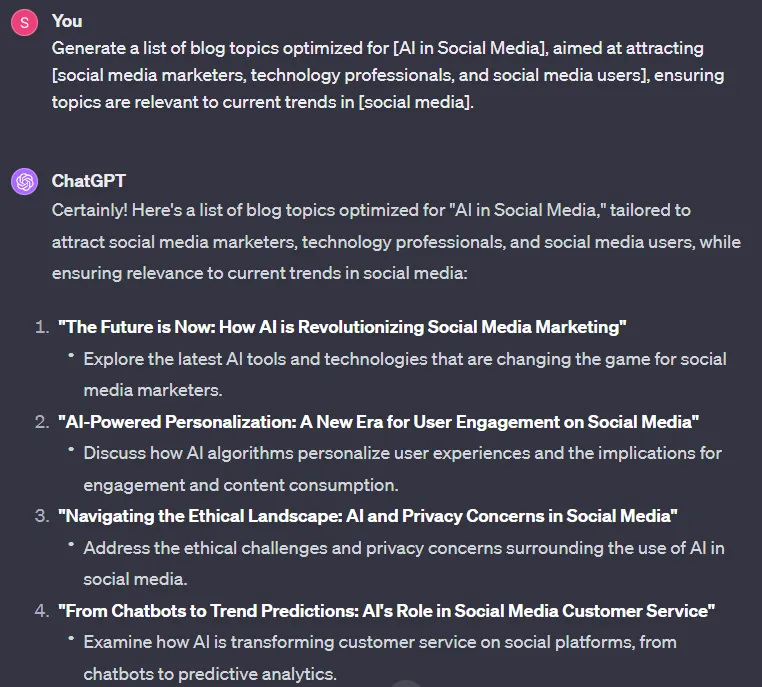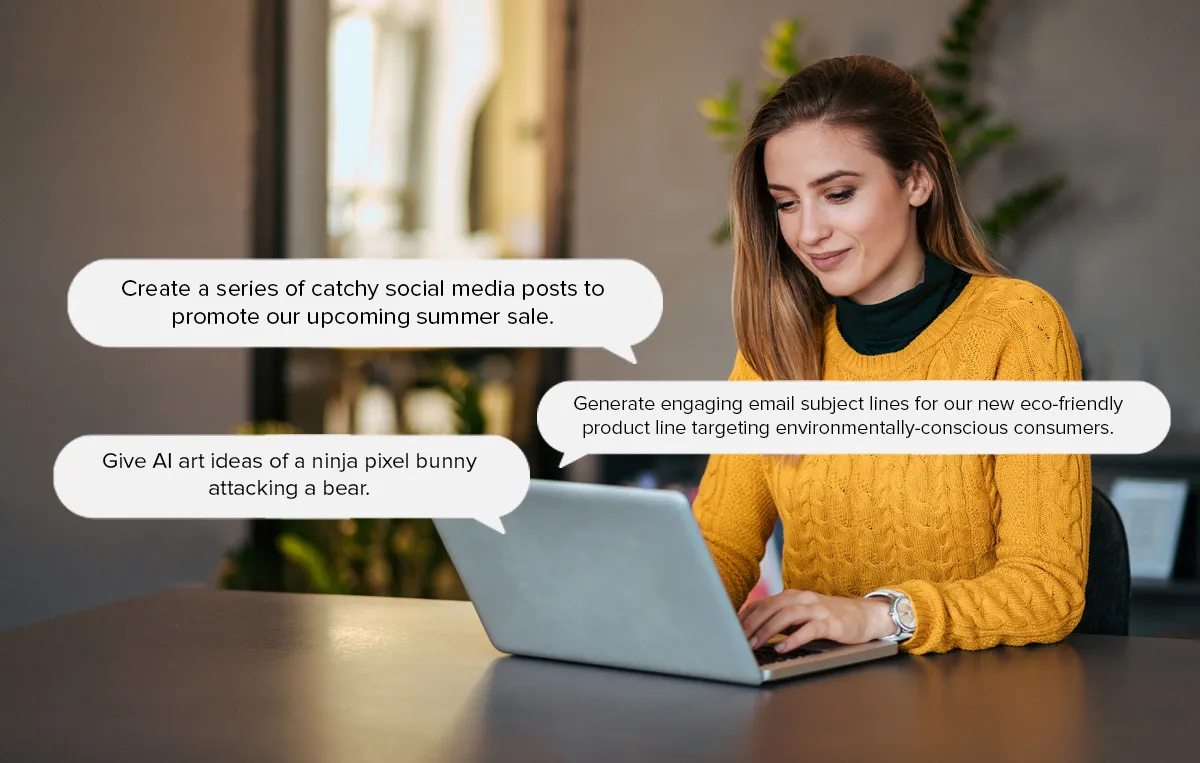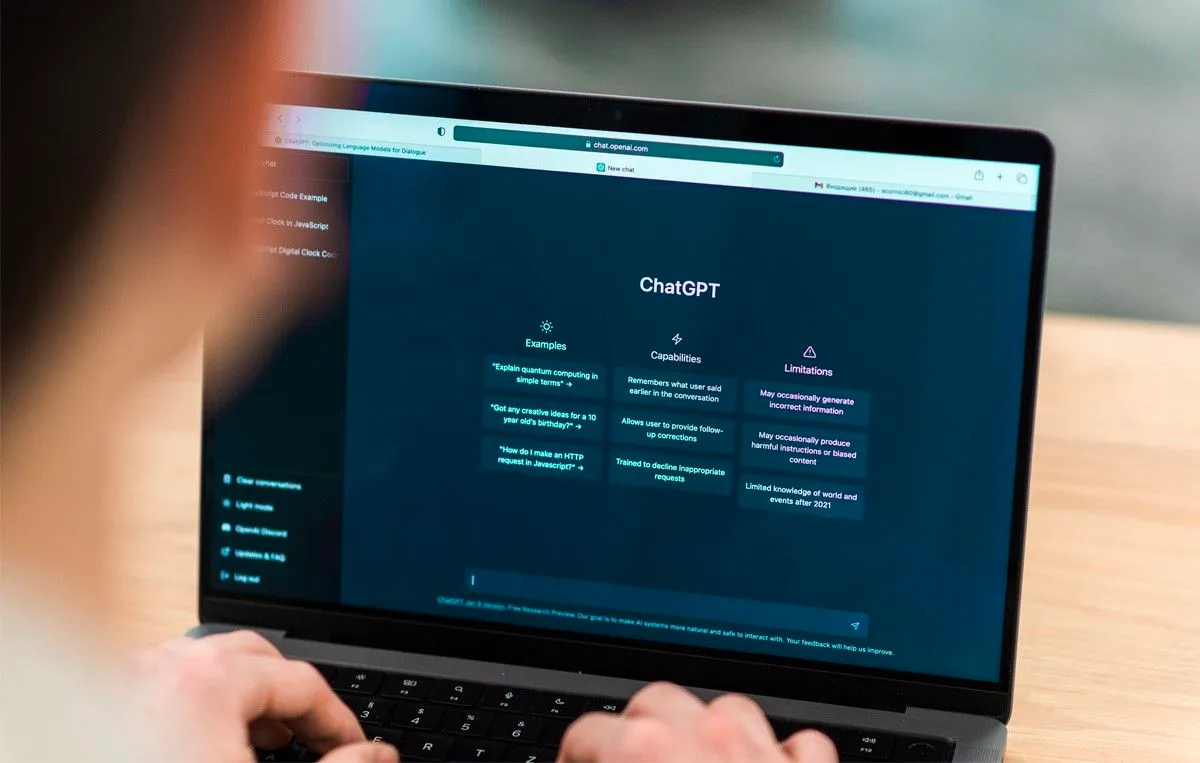Ever wondered how writing a clear and guided AI prompt can set the stage for the content you want to produce? As a content strategist and having to work with AI on a regular basis, I’ve seen firsthand how the right prompts can significantly impact the desired outcomes.
Imagine you’re giving directions to someone; the clearer and more specific your instructions are, the more likely they are to reach the exact destination they wanted. In the same context, a well-crafted AI prompt acts as a clear set of instructions to the AI assistant, guiding it to generate content that perfectly aligns with your marketing objectives.
I have curated a list of 50 AI prompt examples for marketers that you can use to create well-optimized content. From nailing those email subject lines to writing social media posts that pop, these AI prompt examples can come in handy in all scenarios.
Let’s get started!
50 AI Prompt Examples for Marketers
Marketing is a combination of multiple roles and responsibilities under one umbrella. This list of AI prompt examples covers a wide range of marketing roles and tasks, helping marketers leverage AI to generate social media copies, campaign planning, and more.
But how did I create this guide?
To ensure these generative AI prompts help marketers achieve their content creation goals, I assembled my social media and performance marketing team to create this database. We have designed these prompts according to our needs and to drive the output we want.
With some minor changes in the prompts, you can use them to get your desired output.
Let’s get back to the topic.
AI Prompts for Social Media Marketing

While creating AI prompts for social media marketing, it’s crucial to keep them specific and clearly define your objectives, whether it’s generating engaging posts, ad copy, or hashtag ideas.
Instruct the AI on the platform or the format you’re targeting, what product/service you want to promote, who your target customers are, and what exactly you are looking for. Lastly, add any other instructions to fine-tune the outcome.
Here are some examples that you can utilize to create optimized social media drafts:
Note: Don’t just copy and paste these prompts. Modify the prompts according to you, and add your own guidelines to make sure the social media posts created align with your business.
- “Generate a short, engaging Instagram story script that highlights one unique feature of [Product] each day for a week. Include interactive elements like polls or questions to encourage viewer engagement.”
- “Create a Facebook post draft showcasing a recent customer testimonial about [Product/Service]. Include a relatable story and a high-quality image or video of the customer using the product.”
- “Generate a LinkedIn post discussing a recent trend in [Industry]. Provide insights on how it impacts [Target Audience] and include a question at the end to encourage engagement and discussion.”
- “Write me a TikTok postscript that aligns with a current trending challenge, incorporating our [product/service] in a fun and engaging way. The script should include a catchy one-liner to capture attention and a hashtag that relates to the trend.”
- “Create a Snapchat post showcasing a behind-the-scenes look at [Product/Service Development or Team Activity]. The post should be informal and give followers a glimpse into our brand’s culture.”
- “Suggest a YouTube video title for our upcoming tutorial video on [Topic]. Ensure it’s engaging and includes keywords for SEO.”
- “Create a Twitter thread outlining key insights from our recent industry [report]. Share data points, charts, and actionable takeaways in a thread format.”
- “Compose me a marketing plan for Christmas for our newly launched store in [location]. We are targeting [audience category], and we want to increase footfall in our store through content created on social media.
Did you know there are countless ways to use AI in social media? Read more and discover how you can capitalize on it to drive success.
Facebook Post Generator
Generate engaging, high-performing Facebook posts instantly.
Here is the Generated Result

Create More for Free!
Get 500 Credits to Generate AI Content!
Since you’re an AI fanatic, we are offering you 500 Free Credits to generate awesome content on the AI Assistant of SocialPilot.
AI Prompts for Lead Generation
When it comes to lead generation, a lead generator is responsible for attracting and converting strangers into prospects interested in your products/services. When a lead generator writes AI prompts, it is important to keep the prompts guided as they directly impact the generated content’s quality and relevance.
Precise AI prompts lead to content that speaks directly to potential leads, making the lead-generation process a hit.
- “Generate a detailed profile of our ideal customer for [Product/Service], including demographic, psychographic, and behavioral traits to target our marketing efforts.”
- “Write compelling ad copy for a Facebook campaign promoting our [Product/Service], aimed at [Target Audience], with a strong call-to-action for lead capture.”
- “Create ad variations for A/B testing to optimize [Desired Metric] for our Google Ad for [Product/Service].”
- “Develop a sequence of email content for a drip campaign targeted at [Specific Audience Segment], focusing on nurturing leads and guiding them through the sales funnel.”
- “Generate a list of blog post topics that would attract [Target Audience], establish our brand as a thought leader in [Industry], and encourage newsletter sign-ups.”
- “Draft a personalized cold outreach script for LinkedIn messages targeting [Target Professional Role], focusing on how [Product/Service] can solve their specific challenges.”
- “Create an outline for an informative eBook that addresses common pain points in [Industry], to be used as a lead magnet on our website.”
- “Identify high-potential SEO keywords for our [Product/Service] that can drive organic traffic and generate leads through search engines.”
AI Prompts for Videos and Podcasts
Having created tons of content over these years, I can tell you that crafting engaging videos and podcasts is a blend of creativity, strategy, and understanding your audience. Here’s a quick rundown of what you should keep in mind:
Firstly, you need to define the topic, your target audience persona, and a clear word count or duration period. Further, you need to add relevant SEO keywords – because visibility is key to growth.

Here are some prompt examples you can use to start creating content that drives reach and engagement:
- “Generate a list of trending topics in [Specific Industry/Niche] that would appeal to our target audience, focusing on current interests and pain points.”
- “Craft an attention-grabbing opening script for our next podcast/video that hooks the audience within the first 30 seconds, related to [Content Topic].”
- “Suggest SEO-friendly titles for a video series about [Specific Topic], ensuring they are compelling and include targeted keywords for our audience.”
- “Create a variety of strong call-to-action phrases suitable for the end of our videos/podcasts, encouraging viewers to [Desired Action like Subscribe/Comment/Visit a Website].”
- “Produce content ideas for a video series to showcase a behind-the-scenes look at our [company name]. Our company deals in [industry niche].”
- “Develop a theme for a podcast series on mental health and wellness, focusing on topics like mindfulness, work-life balance, and stress management, aimed at [Target Audience].”
- “Suggest a collaboration idea for a podcast/video with [Another Creator/Brand], focusing on [Mutual Topic of Interest], to cross-promote and expand audience reach.”
- “Outline a step-by-step tutorial for a podcast/video on [Specific Skill or Process], ensuring it’s easy to follow for beginners in [Field or Hobby].”
AI Prompts for SEO Blogs
AI models like ChatGPT (3.5 and 4), BARD, or Claude models are trained on plenty of real-world data, and that’s why these can create a good quality blog. But it’s not always the machine that needs to do all the work; as a creator, you have the vision of what you want to create and how.
You need it to convey all the necessary information like blog topic, intent, blog structure (how-to, top 10, or what is), target audience, word count limit, research details, and a CTA. When you input these details, AI has more information to play with and create a well-optimized blog.
- “Generate a list of blog topics optimized for [Primary Keyword/Keyword Phrase], aimed at attracting [Target Audience], ensuring topics are relevant to current trends in [Industry/Niche].”
- “Draft a compelling meta description for a blog post titled [Blog Post Title], including [Primary Keyword] and summarizing key points in under 160 characters.”
- “Generate blog post ideas that cater to local SEO for [Geographic Location], focusing on local events, news, or location-specific advice relevant to [Business Type/Service].”
- “Identify older blog posts on [Website] that could benefit from a content update, focusing on posts related to [Specific Topic or Keyword], and suggest ways to refresh them for current SEO standards.
- “Plan a comprehensive, long-form blog post on [Broad Topic] that covers multiple aspects related to [List of Subtopics]. The blog should motivate readers to [desired action] for [product/service].”
- “Create an SEO-friendly content outline for a blog post about [Topic], including H1, H2, and H3 headings that incorporate targeted keywords and address user intent.”
- “Conduct thorough keyword research to identify high-traffic, low-competition keywords relevant to [Blog Topic], and provide a list of primary and secondary keywords for content optimization.”
- “Provide guidelines for creating short, evergreen URLs for the blog post on [Topic], and write unique meta descriptions that increase organic click-through rates.”
AI Prompts For Email Marketing
With more than 4 billion people using emails across the globe, there is an enormous amount of potential for AI in email marketing. While running email campaigns, I use AI to transform my email copies and make them more persuasive.
If you enter the right prompts, you can use AI as your personal assistant to write compelling emails. I use AI to brainstorm email marketing ideas, craft powerful subject lines, and generate engaging email content.

Here are some of the prompts I use while running email campaigns:
- “Generate a list of innovative email marketing campaign ideas for [Target Audience] focusing on [Product/Service], considering current trends and customer preferences.”
- “Develop a set of engaging subject lines and matching preheaders for a series of emails about [Campaign Topic], ensuring they complement each other and entice recipients to open the email.”
- “Create concise summaries for upcoming email content focused on [Product/Service], highlighting key points and benefits to entice [Target Audience].”
- “Write a draft for a newsletter section about [Specific Topic or Feature], aiming to inform and engage subscribers with a blend of educational and promotional content.”
- “Develop persuasive calls-to-action for our email campaign targeting [Target Audience], encouraging actions such as [Desired Actions – e.g., Sign Up, Learn More, Purchase].”
- “Create a workflow for transforming our latest blog post about [Topic] into an engaging newsletter segment, detailing the process of condensing and adapting the content for email format.”
- “Compose an introduction for our next newsletter, introducing our new [Product Line]. The content should tease the benefits and unique aspects of the new line to excite subscribers.”
- “Generate a re-engagement email targeting subscribers who haven’t interacted with our emails recently. The email should inquire about their preferences and offer a special incentive to re-engage.”
AI Prompts for Event Marketing
Event marketing is a good way to reach the masses and create hype around your product/service only if done correctly. You can use AI to ensure your event campaign is properly planned and the assets required are created keeping your brand guidelines in mind. While using the prompts, give it details like who your attendees are, event details, assets that need to be created, brand guidelines, and more.
Here are the prompts that you can use during your event marketing:
- “Generate innovative concepts for a virtual summit targeting [Target Audience] in [Industry]. Include themes, potential speakers, and unique engagement activities.”
- “Create an email template for reaching out to potential speakers for [Event]. The email should highlight the event’s purpose, expected audience, and speaker benefits.”
- “Develop a compelling sponsorship proposal for [Event], targeting businesses in [Industry]. Include sponsorship levels, benefits, and demographics of our audience.”
- “Design a social media teaser campaign for [Event], creating excitement and intrigue. Include content ideas for [Number of Days] leading up to the event.”
- “Suggest creative interactive session ideas for [Event] that will actively engage participants and facilitate networking, especially in a virtual setting.”
- “Craft an email marketing campaign to promote early bird registration for [Event]. Include incentives for early sign-ups and key event highlights.”
- “Develop a unique event hashtag and a plan for engaging attendees on social media before, during, and after [Event].”
- “Compose an email to registered attendees of [Event] with reminders about the event date, time, access details, and what to expect.”
- “Generate a script for a promotional video highlighting the key features and benefits of attending [Event], targeting [Target Audience].”
- “Write a thank you email for attendees and speakers of [Event], including highlights and expressing gratitude for their participation.”
Thats it with the prompt examples, it’s your time to leverage them and take some action. I have covered a wide range of prompts for multiple roles and responsibilities.
5 Tips to Effectively Use AI Prompts for Marketing
You don’t need to be a prompt engineer to get an accurate response from generative AI. Though understanding how these LLMs work is a blessing, it is not necessary. I’m sharing some insider tips that we use internally in our team to use AI prompts effectively.
You can use insights to reverse engineer the prompts we have given you and get better results:
Start with a Clear Objective
Before you even begin crafting your prompt, be clear about what you want to achieve. Are you looking to generate engaging blog topics, create compelling ad copy, or develop personalized email content?
For example, if your objective is to increase email open rates, your prompt might focus on generating creative subject lines that resonate with your specific audience’s interests.

Detail is Key
AI is incredibly powerful but works best with detailed, specific instructions. When crafting your prompts, include as much context as possible.
For instance, instead of a broad prompt like “Write a blog post on digital marketing,” try “Write a 500-word blog post for beginner marketers about the top 5 SEO strategies in 2024, including examples and actionable tips.”
The more specific your prompt, the more tailored and useful AI can give you output.
Leverage Data Insights
Integrating audience insights into your prompts can significantly improve the relevance and effectiveness of AI-generated content. If your data shows that a particular topic or style resonates with your audience, use that information to guide your prompts.
Let’s say that analytics indicate that your audience engages more with how-to guides. Your prompt could be “Create a step-by-step guide on using social media for brand growth, targeted at small business owners.”
Iterate and Optimize
The first output from an AI prompt may not always be perfect. Use it as a starting point and refine your prompts based on the initial results. Iterative testing can help you discover your prompts’ best formulations and structures.
You can try tweaking the prompt to adjust the content’s tone, length, or focus if an AI-generated blog post doesn’t quite hit the mark.
Combine AI Creativity with Human Insight
AI can generate creative and diverse content ideas, but it lacks the nuanced understanding of a human marketer. Use AI-generated content as a base and infuse it with your unique brand voice and insights.
I use AI to create a list of potential blog topics and use my understanding of our target audience and industry trends to select and refine the topics that can be most impactful.

Though I will also use SEO to find content gaps in our SILO and then iterate some ideas, these blog topics are good for someone to start with.
By using these tips, you can improve AI prompts, generate content that you always wanted, and save time that you would have spent doing back and forth with AI.
Add process-oriented thoughts from Anoob/Khanjan
- What are the core components of an effective AI prompt for digital marketing purposes?
- How can a marketer ensure their AI prompts align with their overall marketing strategy and goals?
- What are common mistakes to avoid when writing AI prompts for marketing campaigns?
Accelerate Your Marketing Efforts with These AI Prompts
To sum up this blog, remember the key is to start with clear objectives, add detailed instructions, utilize data insights, continuously iterate, and blend AI creativity with human insight.
As you apply these strategies, consider leveraging tools like SocialPilot’s AI assistant to streamline and enhance your marketing efforts. SocialPilot’s AI assistant makes content creation easier for social media marketers and creators, just input your prompt, select the platform, tone of voice, and hit Generate.
The AI assistant will create an informative and engaging LinkedIn post for you that your audience will love. After your post content is ready, you can add media to your post and schedule or publish on the best time to publish directly from SocialPilot’s dashboard.
Isn’t this amazing, you will save so much time automating these rigorous tasks and utilize time to brainstorm content ideas, design assets, or increase marketing efforts.



